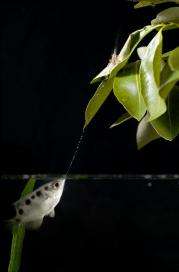Fishy research confirms archerfish seeing clearer

(PhysOrg.com) -- If you have ever looked up from the depths of the ocean, you will understand how difficult it can be to identify objects above the surface.
Now University of Queensland scientists at the Queensland Brain Institute and School of Biomedical Sciences have identified a fish that can clearly visualise both the water and air mediums simultaneously.
Archerfish live in mangroves and rivers. Their unique vision not only allows them to see above and below the water surface but also to easily distinguish shades of brown in the depths of the water, detect dark objects against the bright blue sky and to recognise tiny colourful objects from great distances against a backdrop of green foliage.
“Archerfish spit jets of water with remarkable accuracy at insects as much as a meter or more above the water's surface, despite the distortion that occurs due to the bending of light as it passes from air to water. They do all this while being attentive to potential predators approaching from above or below” said lead investigator Dr Shelby Temple.
Already the research, published in Proceedings of the Royal Society: Biological Sciences and featured in the latest edition of Nature, has far-reaching impacts.
Dr Temple said the findings provided the first empirical evidence for a functional role for differences in colour vision across the eye - a phenomenon found in most vertebrate taxa such as humans, mice, pigeons, chameleons, bullfrogs and some fish. However, to date, there is no explanation for why different parts of the eye might need to see colours differently.
“The correlation we found between the colour sensitivity of the archerfish eye for ‘looking' in different directions and the background environment in those different directions indicates that the archerfish eye is highly tuned to differences in the spectral quality of light in different directions,” he said.
“Our findings might help to solve why such intraretinal differences exist in so many other vertebrate eyes.”
Dr Temple's supervisor, Professor Justin Marshall, said it was fascinating to try and understand how other animals saw their world.
"As this story shows, when they have specific necessary tasks, animals often come up with remarkable adaptations to help them survive," Professor Marshall said.
“The innovation in design here is called ‘matched filtering' where the visual system takes into account the environment and, through evolution, adjusts its self to the outside world. Under water, this world changes more rapidly from top to bottom than it does in air and archerfish have come up with a neat system of accounting for this change and retaining exquisitely tuned vision in every direction at once. This design principle is something we can learn from in our own attempts at engineering.”
Provided by University of Queensland

















